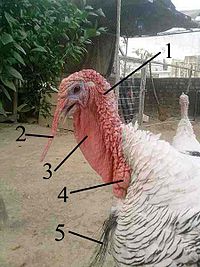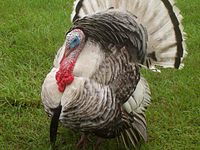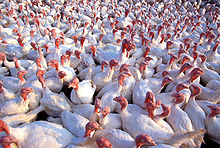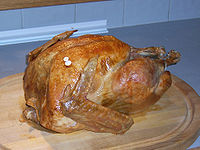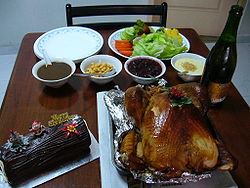
Domesticated turkey
Background to the schools Wikipedia
SOS Children, which runs nearly 200 sos schools in the developing world, organised this selection. SOS Children is the world's largest charity giving orphaned and abandoned children the chance of family life.
| Domesticated turkey | |
|---|---|
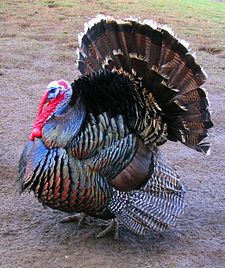 |
|
| A Broad Breasted Bronze tom displaying | |
| Conservation status | |
|
Domesticated
|
|
| Scientific classification | |
| Kingdom: | Animalia |
| Phylum: | Chordata |
| Class: | Aves |
| Order: | Galliformes |
| Family: | Meleagridinae |
| Genus: | Meleagris |
| Species: | M. gallopavo |
| Binomial name | |
| Meleagris gallopavo (Linnaeus, 1758) |
|
The domesticated turkey is a large poultry bird. The modern domesticated form descends from the wild turkey (Meleagris gallopavo), one of the two species of turkey (genus Meleagris). It was domesticated by the indigenous peoples of Mesoamerica at least 2,000 years ago, with the evidence pointing to what are today the central regions of Mexico.
The turkey is raised throughout temperate parts of the world and is a popular form of poultry, partially because industrialized farming has made it very cheap for the amount of meat it produces. The female domesticated turkey is referred to as a hen and the chick as a poult or turkeyling. In the United States, the male is referred to as a tom, while in Europe, the male is a stag. The average lifespan for a domesticated turkey is ten years.
The great majority of domesticated turkeys are bred to have white feathers because their pin feathers are less visible when the carcass is dressed, although brown or bronze-feathered varieties are also raised. The fleshy protuberance atop the beak is the snood, and the one attached to the underside of the beak is known as a wattle.
The bird has the same name as the country of Turkey due to an early misidentification of the bird with another unrelated species which was imported to Europe through the country; see further under Turkey (bird): History and naming.
History
The modern domesticated turkey is descended from one of six subspecies of wild turkey: Meleagris gallopavo, found in the area bounded by the present Mexican states of Jalisco, Guerrero, and Veracruz Ancient Mesoamericans domesticated this subspecies, using its meat and eggs as major sources of protein and employing its feathers extensively for decorative purposes. The Aztecs associated the turkey with their trickster god Tezcatlipoca, perhaps because of its perceived humorous behaviour.
Domestic turkeys were taken to Europe by the Spanish. Many distinct breeds were developed in Europe (e.g. Spanish Black, Royal Palm). In the early 20th century, many advances were made in the breeding of turkeys, resulting in breeds such as the Beltsville Small White.
The 16th-century English navigator William Strickland is generally credited with introducing the turkey into England. His family coat of arms — showing a turkey cock as the family crest — is among the earliest known European depictions of a turkey. English farmer Thomas Tusser notes the turkey being among farmer's fare at Christmas in 1573. The domestic turkey was sent from England to Jamestown, Virginia in 1607. A document written in 1584 lists supplies to be furnished to future colonies in the New World; "turkies, male and female".
Prior to the late 19th century, turkey was something of a luxury in the UK, with goose or beef a more common Christmas dinner among the working classes. In Charles Dickens' A Christmas Carol (1843), Bob Cratchit had a goose before Scrooge bought him a turkey.
Turkey production in the UK was centered in East Anglia, using two breeds, the Norfolk Black and the Norfolk Bronze (also known as Cambridge Bronze). These would be driven as flocks, after shoeing, down to markets in London from the 17th century onwards - the breeds having arrived in the early 16th century via Spain.
Intensive farming of turkeys from the late 1940s dramatically cut the price, making it more affordable for the working classes. With the availability of refrigeration, whole turkeys could be shipped frozen to distant markets. Later advances in disease control increased production even more. Advances in shipping, changing consumer preferences and the proliferation of commercial poultry plants has made fresh turkey inexpensive as well as readily available.
Behaviour
Young domestic turkeys readily fly short distances, perch and roost. These behaviours become less frequent as the birds mature, but adults will readily climb on objects such as bales of straw. Young birds perform spontaneous, frivolous running ('frolicking') which has all the appearance of play. Commercial turkeys show a wide diversity of behaviours including 'comfort' behaviours such as wing-flapping, feather ruffling, leg stretching and dust-bathing. Turkeys are highly social and become very distressed when isolated. Many of their behaviours are socially facilitated i.e. expression of a behaviour by one animal increases the tendency for this behaviour to be performed by others. Adults can recognise 'strangers' and placing any alien turkey into an established group will almost certainly result in that individual being attacked, sometimes fatally. Turkeys are highly vocal, and 'social tension' within the group can be monitored by the birds’ vocalisations. A high-pitched trill indicates the birds are becoming aggressive which can develop into intense sparring where opponents leap at each other with the large, sharp talons, and try to peck or grasp the head of each other. Aggression increases in frequency and severity as the birds mature.
Maturing males spend a considerable proportion of their time sexually displaying. This is very similar to that of the wild turkey and involves fanning the tail feathers, drooping the wings and erecting all body feathers, including the 'beard' (a tuft of black, modified hair-like feathers on the centre of the breast). The skin of the head, neck and caruncles (fleshy nodules) becomes bright blue and red, and the snood (an erectile appendage on the forehead) elongates, the birds 'sneeze' at regular intervals, followed by a rapid vibration of their tail feathers. Throughout, the birds strut slowly about, with the neck arched backward, their breasts thrust forward and emitting their characteristic 'gobbling' call.
Turkey breeds
- The Broad Breasted White is the commercial turkey of choice for large scale industrial turkey farms, and consequently is the most consumed variety of the bird. Usually the turkey to receive a "presidential pardon", a U.S. custom, is a Broad Breasted White.
- The Broad Breasted Bronze is another commercially developed strain of table bird.
- The Standard Bronze looks much like the Broad Breasted Bronze, except that it is single breasted, and can naturally breed.
- The Bourbon Red turkey is a smaller, non-commercial breed with dark reddish feathers with white markings.
- Slate, or Blue Slate, turkeys are a very rare breed with beautiful gray-blue feathers.
- The Black ("Spanish Black", "Norfolk Black") has very dark plumage with a green sheen.
- The Narragansett Turkey is a popular heritage breed named after Narraganset Bay in New England.
- The Chocolate is a rarer heritage breed with markings similar to a Black Spanish, but light brown instead of black in colour. Common in the Southern U.S. and France before the Civil War.
- The Beltsville Small White is a small heritage breed, whose development started in 1934. The breed was introduced in 1941 and was admitted to the APA Standard in 1951. Although slightly bigger and broader than the Midget White, both are often mislabeled.
- The Midget White is a smaller heritage breed.
Commercial production
In commercial production, breeder farms supply eggs to hatcheries. After 28 days of incubation, the hatched poults are sexed and delivered to the grow-out farms; hens are raised separately from toms because of different growth rates.
In the UK, it is common to rear chicks in the following way. Between one and seven days of age, chicks are placed into small (2.5m) circular brooding pens to ensure they encounter food and water. To encourage feeding, they may be kept under constant light for the first 48 hours. To assist thermoregulation, air temperature is maintained at 35°C for the first three days, then lowered by approximately 3°C every two days to 18°C at 37 days of age, and infra-red heaters are usually provided for the first few days. Whilst in the pens, feed is made widely accessible by scattering it on sheets of paper in addition to being available in feeders. After several days, the pens are removed, allowing the birds access to the entire rearing shed, which may contain tens of thousands of birds. The birds remain there for several weeks, after which they are transported to another unit.
The vast majority of turkeys are reared indoors in purpose-built or modified buildings of which there are many types. Some types have slatted walls to allow ventilation, but many have solid walls and no windows to allow artificial lighting manipulations to optimise production. The buildings can be very large (converted aircraft hangers are sometimes used) and may contain tens of thousands of birds as a single flock. The floor substrate is usually deep-litter, e.g. wood shavings, which relies upon the controlled build-up of a microbial flora requiring skilful management. Ambient temperatures for adult domestic turkeys are usually maintained between 18 and 21°C. High temperatures should be avoided because the high metabolic rate of turkeys (up to 69W/bird) makes them susceptible to heat stress, exacerbated by high stocking densities. Commercial turkeys are kept under a variety of lighting schedules, e.g. continuous light, long photoperiods (23 h), or intermittent lighting, to encourage feeding and accelerate growth. Light intensity is usually low (e.g. less than one lux) to reduce feather pecking.
Rations generally include corn and soybean meal, with added vitamins and minerals, and is adjusted for protein, carbohydrate and fat based on the age and nutrient requirements. Hens are slaughtered at about 14–16 weeks and toms at about 18–20 weeks of age when they can weigh over 20 kg compared to a mature male wild turkey which weighs approximately 10.8 kg.
Welfare concerns
Space allowance for commercially reared turkeys is often severely limited. For example, recommendations by the Farm Animal Welfare Council equate to providing adult birds each weighing 20 kg with 891 cm2, despite turkeys of this weight each requiring 1700 cm2 simply to stand without touching another bird.
The problems of small space allowance are exacerbated by the major influence of social facilitation on the behaviour of turkeys. If turkeys are to feed, drink, dust-bathe, etc., simultaneously, then to avoid causing frustration, resources and space must be available in large quantities.
Lighting manipulations used to optimise production can compromise welfare. Long photoperiods combined with low light intensity can result in blindness from buphthalmia (distortions of the eye morphology) or retinal detachment.
Feather pecking occurs frequently amongst commercially reared turkeys and can begin at 1 day of age. This behaviour is considered to be re-directed foraging behaviour, caused by providing poultry with an impoverished foraging environment. To reduce feather pecking, turkeys are often beak-trimmed, which has its own ethical concerns. Ultraviolet-reflective markings appear on young birds at the same time as feather pecking becomes targeted toward these areas, indicating a possible link. Commercially reared turkeys also perform head-pecking, which becomes more frequent as they sexually mature. When this occurs in small enclosures or environments with few opportunities to escape, the outcome is often fatal and rapid. Frequent monitoring is therefore essential, particularly of males approaching maturity. Injuries to the head receive considerable attention from other birds, and head-pecking often occurs after a relatively minor injury has been received during a fight or when a lying bird has been trodden upon and scratched by another. Individuals being re-introduced after separation are often immediately attacked again - it may be impossible to re-introduce head-pecked individuals. Fatal head-pecking can occur even in small (10 birds), stable groups. Commercial turkeys are normally reared in single-sex flocks. If a male is inadvertently placed in a female flock, he may be aggressively victimised (hence the term 'henpecked'). Females in male groups will be repeatedly mated, during which it is highly likely she will be injured from being trampled upon.
Waste products
Approximately two to four billion pounds of poultry feathers are produced every year by the poultry industry. Most are ground into a protein source for ruminant animal feed, which are able to digest the protein keratin of which feathers are composed. Researchers at the United States Department of Agriculture (USDA) have patented a method of removing the stiff quill from the fibers which make up the feather. As this is a potential supply of natural fibers, research has been conducted at Philadelphia University's School of Engineering and Textiles to determine textile applications for feather fibers. Turkey feather fibers have been blended with nylon and spun into yarn, and then used for knitting. The yarns were tested for strength while the fabrics were evaluated as insulation materials. In the case of the yarns, as the percentage of turkey feather fibers increased, the strength decreased. In fabric form, as the percentage of turkey feather fibers increased, the heat retention capability of the fabric increased.
Turkeys as food
| Nutritional value per 100 g (3.5 oz) | |
|---|---|
| Energy | 465 kJ (111 kcal) |
| Carbohydrates | 0 g |
| - Sugars | 0 g |
| - Dietary fibre | 0 g |
| Fat | 0.7 g |
| Protein | 24.6 g |
| Thiamine (vit. B1) | 0 mg (0%) |
| Riboflavin (vit. B2) | 0.1 mg (8%) |
| Niacin (vit. B3) | 6.6 mg (44%) |
| Pantothenic acid (B5) | 0.7 mg (14%) |
| Vitamin B6 | 0.6 mg (46%) |
| Folate (vit. B9) | 8 μg (2%) |
| Vitamin C | 0 mg (0%) |
| Calcium | 10 mg (1%) |
| Iron | 1.2 mg (9%) |
| Magnesium | 28 mg (8%) |
| Phosphorus | 206 mg (29%) |
| Potassium | 293 mg (6%) |
| Sodium | 49 mg (3%) |
| Zinc | 1.2 mg (13%) |
| Percentages are relative to US recommendations for adults. Source: USDA Nutrient Database |
|
Turkeys are traditionally eaten as the main course of Christmas feasts in much of the world ( stuffed turkey) since appearing in England in the 16th century, as well as for Thanksgiving in the United States and Canada, though this tradition has its origins in modern times, rather than colonial as is often supposed. Before the 20th century, pork ribs were the most common food on the holiday, as the animals were usually slaughtered in November. Turkeys were once so abundant in the wild that they were eaten throughout the year, the food considered commonplace, whereas pork ribs were rarely available outside of the Thanksgiving-New Year season. While the tradition of turkey at Christmas spread throughout England in the 17th century, among the working classes it became common to serve goose, which remained the predominant roast until the Victorian era. While eating turkey was once mainly restricted to special occasions such as these, turkey is now eaten year-round and forms a regular part of many diets.
Turkeys are sold sliced and ground, as well as "whole" in a manner similar to chicken with the head, feet, and feathers removed. Frozen whole turkeys remain popular. Sliced turkey is frequently used as a sandwich meat or served as cold cuts; in some cases where recipes call for chicken it can be used as a substitute. Ground turkey is sold just as ground beef, and is frequently marketed as a healthy beef substitute. Without careful preparation, cooked turkey is usually considered to end up less moist than other poultry meats such as chicken or duck. Leftovers from roast turkey are generally served as cold cuts on Boxing Day in the UK & Canada.
Wild turkeys, while technically the same species as domesticated turkeys, have a very different taste from farm-raised turkeys. Almost all of the meat is "dark" (even the breast) with a more intense flavor. The flavor can also vary seasonally with changes in available forage, often leaving wild turkey meat with a gamier flavor in late summer due to the greater number of insects in its diet over the preceding months. Wild turkey that has fed predominantly on grass and grain has a milder flavor. Older heritage breeds also differ in flavor.
A large amount of turkey meat is processed. It can be smoked and as such is sometimes sold as turkey ham. Twisted helices of deep fried turkey meat, sold as " turkey twizzlers," came to prominence in the UK in 2004 when chef Jamie Oliver campaigned to have them and similar foods removed from school dinners.
Unlike chicken, duck, and quail eggs, turkey eggs are not commonly sold as food due to the high demand for whole turkeys and lower output of eggs as compared with other fowl. The value of a single turkey egg is estimated to be about US $3.50 on the open market, substantially more than a carton of one dozen chicken eggs.
In the UK in 2009, 7,734,000 turkeys were consumed on Christmas Day. (stat from Oak House).
Cooking
Wikibooks Cookbook has a recipe/module on
|
Both fresh and frozen turkeys are used for cooking; as with most foods, fresh turkeys are generally preferred, although they cost more. Around holiday seasons, high demand for fresh turkeys often makes them difficult to purchase without ordering in advance. For the frozen variety, the large size of the turkeys typically used for consumption makes defrosting them a major endeavor: a typically sized turkey will take several days to properly defrost.
Turkeys are usually baked or roasted in an oven for several hours, often while the cook prepares the remainder of the meal. Sometimes, a turkey is brined before roasting to enhance flavor and moisture content. This is necessary because the dark meat requires a higher temperature to denature all of the myoglobin pigment than the white meat (very low in myoglobin), so that fully cooking the dark meat tends to dry out the breast. Brining makes it possible to fully cook the dark meat without drying the breast meat. Turkeys are sometimes decorated with turkey frills prior to serving.
In some areas, particularly the American South, they may also be deep fried in hot oil (often peanut oil) for 30 to 45 minutes by using a turkey fryer. Deep frying turkey has become something of a fad, with hazardous consequences for those unprepared to safely handle the large quantities of hot oil required.
Nutritional value
The white meat of turkey is generally considered healthier than dark meat because of its lower fat content, but the nutritional differences are small. And although turkey is reputed to cause sleepiness, holiday dinners are commonly large meals served with carbohydrates, fats, and alcohol in a relaxed atmosphere, all of which are bigger contributors to post-meal sleepiness than the tryptophan in turkey.
Accompaniments
Wikibooks Cookbook has a recipe/module on
|
When eaten at Christmas in the United Kingdom, turkey is traditionally served with winter vegetables including roast potatoes, Brussels sprouts and parsnips. Cranberry sauce is the traditional condiment in the northern rural areas of the United Kingdom where wild cranberries grow. In the south and in urban areas, where cranberries until recently were difficult to obtain, bread sauce was used in its place, but the availability of commercial cranberry sauce has seen a rise in its popularity in these areas too. Sometimes sausage meat, cocktail sausages or liver wrapped in bacon is also served (known as bacon rolls or " pigs in blankets").
Especially during holiday seasons, stuffing, also known as dressing, is traditionally served with turkey. There are many varieties: oatmeal, chestnut, sage and onion (flavored bread), cornbread, and sausage are the most traditional. Stuffing may either be used to stuff the turkey (as the name implies), or may be cooked separately and served as a side dish.
For Thanksgiving in the United States and Canada, turkey is typically served stuffed or with dressing (on the side), with cranberry sauce and gravy. Common complementary dishes include mashed potatoes, corn, green beans, squash, and sweet potatoes. In the Baltimore, MD area, sauerkraut is a popular side dish for turkey. Pie is the usual dessert, pumpkin being most traditional, apple or pecan also being popular.
Turkey is sometimes used as a substitute for other meats in foods like turkey bacon and turkey hot dogs.
Turkey litter for fuel
Although most commonly used as fertilizer, turkey litter (droppings mixed with bedding material, usually wood chips) is being used as a fuel source in electric power plants. One such plant in western Minnesota provides 55 megawatts of power using 500,000 tons of litter per year. The plant began operating in 2007.

